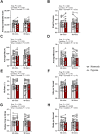Gamified assessment of cognitive performance during moderate hypoxia
- PMID: 37459310
- PMCID: PMC10351691
- DOI: 10.1371/journal.pone.0288201
Gamified assessment of cognitive performance during moderate hypoxia
Abstract
Introduction: There is a need for rapid and objective assessment tools to identify people at risk of impaired cognitive function during hypoxia.
Purpose: To test the hypotheses that performance on gamified cognitive tests examining the cognitive domains of executive function (Gridshot), working memory (Capacity) and spatial tracking (Multitracker) will be reduced during normobaric exposure to moderate normobaric hypoxia.
Methods: Following three consecutive days of practice, twenty-one healthy adults (27 ± 5 y, 9 females) completed five 1-min rounds of the tablet-based games Gridshot, Capacity, and Multitracker (Statespace Labs, Inc.) at Baseline and 60 and 90 min after exposure to 14.0 ± 0.2% (hypoxia) and 20.6 ± 0.3% (normoxia) oxygen. Both conditions were completed on the same day and were administered in a single-blind, block randomized manner. Arterial oxyhemoglobin saturation was estimated via forehead pulse oximetry (SpO2). Data were analyzed using ANCOVA with a covariate of Baseline.
Results: Compared to normoxia (98 ± 1%), SpO2 was lower (p < 0.001) at 60 (91 ± 3%) and 90 (91 ± 2%) min of hypoxia. No condition x time interaction effects were identified for any gamified cognitive tests (p ≥ 0.32). A main effect of condition was identified for Capacity (p = 0.05) and Multitracker (p = 0.04), but not Gridshot (p = 0.33). Post hoc analyses of the composite scores for both Capacity (p = 0.11) and Multitracker (p = 0.73) demonstrated no difference between conditions.
Conclusion: Performance on gamified cognitive tests was not consistently affected by acute normobaric moderate hypoxic exposure.
Copyright: © 2023 Keeler et al. This is an open access article distributed under the terms of the Creative Commons Attribution License, which permits unrestricted use, distribution, and reproduction in any medium, provided the original author and source are credited.
Conflict of interest statement
I have read the journal’s policy and the authors of this manuscript have the following competing interests: JL is employed by Statespace Labs. DH is a paid consultant for Statespace Labs. ZLS and NLP received funding from Statespace Labs for this work. " This does not alter our adherence to PLOS ONE policies on sharing data and materials.
Figures




References
Publication types
MeSH terms
Substances
LinkOut - more resources
Full Text Sources

